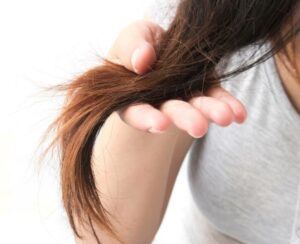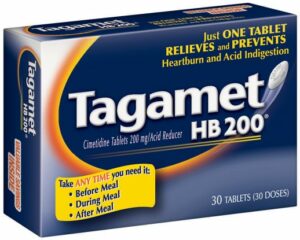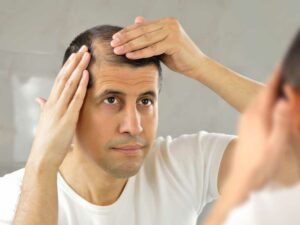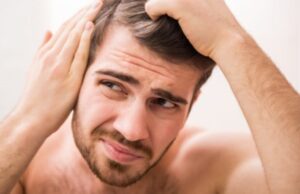Introduction:
The skin is the largest organ in the body and of primary importance, integral to the survival of mammalian life but often overlooked when examining the health and welfare of an individual. The heterogeneous skin structure is derived from the ectoderm and mesoderm of an embryo giving rise to the epidermis and dermis respectively. Within these generalised layers are specialised appendages also derived from the ectoderm and/or mesoderm including sensory nerves, sweat glands and hair follicles. The skin as a whole rests on subcutaneous tissue largely composed of a loose mesh of collagen fibre, fat cells and muscle tissue.
The skin has a diverse range of functions:
Support :
The skin acts as a flexible physical support and covering for underlying tissues.
Temperature:
Through its extensive blood supply and sweat glands, the mammalian skin is able to maintain the constant temperature of a homeotherm.
Excretion:
Waste materials such as salts and water are removed from the body via the skin.
Vitamin formation:
Photochemical action on skin promotes the production of vitamin D. Ths skin is our primary source.
Sensory function:
Through the extensive network of sensory receptors sensations of pressure, texture, temperature and pain.
Pigmentation:
Melanin pigments protect against the excesses of ultra violet rays.
Protection:
The epidermis prevents absorption of unwanted, potentially dangerous materials and desiccation of the internal organs and so provides the fundamental requirement for mammalian land colonisation – freedom from water dependence.
Immunological defence:
The epidermis, particularly the stratum corneum (the outer most keratinized skin layer), provides a passive defence against entry of opportunistic infecting organisms and also performs an active role in immunity through immunological surveillance by epidermal Langerhan’s cells.
In short, the skin acts as a barrier and is the primary organ through which we interact with the external world.
Significant in many of these properties is the hair follicle appendage. Hair provides protection against heat loss by adjustment of hair density through contraction of the arrector pili muscle attached to each hair follicle. By “fluffing up” the hair layer air can be held adjacent to the skin to provide a heat-trapping, invisible layer. Hair can provide indications of sexual development through onset of secondary sexual characteristics from the development of a mane on a male lion to beard development in humans. Hair may also be of importance in attracting mates and may be based on color – such as silver back mountain gorillas – distribution or quality, all indicators of the general health and vitality of an individual. Alternatively, it may aid in camouflage for survival where mute tones or dappled color blend with an animal’s environment. Hair fibre also helps with protection forming a tough barrier helping protect the epidermis from minor abrasions and/or from ultra violet light. Specialized hair such as eyebrows and eyelashes protect the eyes by channeling or sweeping away fluids, dust and debris. Nasal hair plays an important role in trapping air borne foreign particles before reaching the lungs. Hair fibre may also increase the surface area for faster evaporation of sweat from neighboring glands and individual hairs can aid sensory function. Consequently the hair follicle is of importance to the survival of mammals and still maintains significance for the human race – not just biologically, but also through cosmetic and commercial considerations.
Hair Follicle Morphology:
The total number of hair follicles for an adult human is estimated at 5 million with 1 million on the head of which 100,000 alone cover the scalp. In humans, the only external regions of skin devoid of hair follicles are the palms of the hands and soles of the feet. The basic hair follicle structure remains essentially the same throughout the range of mammalian species with modifications for specialised functions. The hair follicle can be recognised as a separate entity within the skin with formation and maintenance based on interaction between dermal and epidermal components. At the heart of each anagen hair follicle lays the dermal papilla (DP). The dermal papilla (DP) presents as a healthy “pear” shape in normal hair follicles (in alopecia areata the DP becomes small and the cells densely packed). As the name suggests, derived from the dermis mesenchyme the DP consists of a highly active group of cells shown to be capable of inducing follicle development from the epidermis and production of hair fibre. Under the influence of the DP, epidermal cell differentiation during anagen produces a keratinized hair fibre and associated products. The source epidermal cells (called cortical or matrix cells) which lie in the immediate vicinity of the dermal papilla are a living, actively proliferating group of cells which differentiate and become keratinized to form the hair cortex (Co) and surrounding hair cuticle (Hc) of the hair shaft at the centre of which is situated the medulla (M). Cells Around the hair shaft comprise the inner root sheath (IRS) which can be divided into three layers the cuticle (Cu), Huxley layer (Hu) and Henle layer (He) based on structure, patterns of keratinisation and incorporation of a product called trichohyalin. The IRS breaks down at the level of the sebaceous gland to leave only the hair cortex and surrounding cuticle to protrude above the epidermis.
Diagram showing the main differentiated layers in a mature anagen hair follicle. The hair follicle penetrates the dermal layer of the skin composed of fibroblast cells and collagen connective tissue interspersed with blood vessels, sweat glands and sensory nerves. The bulb region sits just above the subcutaneous (adipose fat) tissue layer.
The Outer Root Sheath (ORS) is distinct from other epidermal components of the hair follicle being continuous with the epidermis. The “bulge” region in the ORS is the site at which the arrector pili muscle is attached (not shown). This is the muscle that makes hair stand erect and produces “goose bumps” when you are cold. Isolating epidermal tissue from the dermis in anagen, hair shaft producing follicles (between the IRS and ORS), is a basement membrane (BM) described as the glassy membrane within the hair follicle. In other words, the BM provides a physical dividing line between cells descendant from embryonic ectoderm (epidermis) and embryonic mesoderm (dermis). This physical barrier has a role to play in our immunological protection. For human and other hair follicles, a dermal sheath (DS) encloses the epidermal component and consists of a thin layer of mesenchymal cells extending from the stratum papillaris to the dermal papilla (on the outside of the ORS layer running the full length of the hair follicle – not shown in diagram).
Hair Follicle Induction:
In embryogenesis the establishment of a DP is vital to the development of all hair follicles and associated modified structures. The DP is a group of specialized dermal fibroblast cells, derived from the embryonic mesoderm, which aggregate in the dermis just below the epidermis. For humans this initial aggregation begins when the embryo is approximately 60 days old. The DP cells at this stage are only loosely collected and present as long, spindle shaped. Within the skin the development of a DP marks the site for future development of a hair follicle.
Above the DP an epidermal plug, or peg, of cells develops and proliferates growing into the dermis to link with the DP. The mesoderm derived DP and the ectoderm derived epidermal plug apparently “communicate” with the result of further proliferation of epidermal matrix cells and differentiation into the various sheath and hair fibre structures. The DP develops into a more identifiable structure of rounded cells containing organelles vital for product synthesis, although the cells themselves at this later stage of development are non-proliferative. Hence, development of a hair follicle requires a continuum through induction, initiation, elongation and differentiation.

Diagram showing accumulation of dermal papilla cells below undifferentiated epidermis which is then stimulated to grow down into the dermis as a hair “peg”. Interaction between the hair peg and the dermal papilla cells promotes differentiation into a mature hair follicle.
It is the DP which directs and dictates the embryonic generation of a hair follicle and it also retains this instructive ability throughout the life of the hair follicle. Oliver et al revealed that the removal of the DP stops hair growth but that the lower third of the dermal sheath is capable of supplying new cells for regeneration of a new DP by infiltrating and transforming at the site of the original DP with subsequent hair follicle regrowth. With removal of more than the lower third of a hair follicle, reformation of a DP is unable to occur and the hair follicle is effectively permanently destroyed. The DP cells retain their embryonic functional abilities and are able to induce new hair fibre growth in mature, adult skin when implanted into previously deactivated hair follicles and in close association with ORS epidermal cells.
DP cells can also interact with adult epidermis to induce the development of new hair follicles. In the established hair follicle the DP cells act in conjunction with epidermal cells via mechanisms similar to those in embryogenesis to permit hair follicle cycling through hair production and resting phases. DP cells are almost unique in maintaining their embryogenic regenerative properties in adults making them potentially attractive for investigation with a view to gaining an insight on organ/limb regeneration and similar studies.
Hair Follicle Cycle:
Under normal circumstances hair growth in each hair follicle occurs in a cycle. There are three main phases of the hair growth cycle; anagen, catagen and telogen with anagen further subdivided into proanagen, mesanagen and metanagen. Anagen is the active growth phase when hair fibre is produced. Proanagen marks initiation of growth with RNA and DNA synthesis in a follicle which then quickly progresses through mesanagen to metanagen and maximum follicle length and girth. In this mature state of proliferation and differentiation the hair follicle consists of a total of eight concentric layers and melanogenesis occurs within pigmented hair follicles. Anagen is followed by catagen, a period of controlled regression of the hair follicle. Ultimately the hair follicle enters telogen, when the follicle is in a so-called resting state.
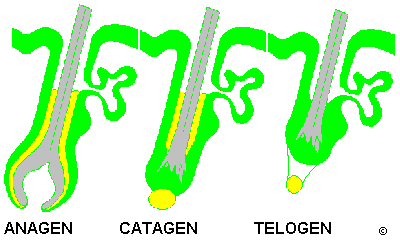
Anagen is the longest phase with up to 90% of follicles on a normal human scalp in this active hair growth state at any given time and correspondingly telogen hair follicles comprise up to 10% on the scalp. The average rate of hair fibre growth is around 0.35mm a day but this rate varies depending on the site of the hair follicle and the age and sex of the individual. The length of the anagen growth phase for scalp hair is usually 6-10 years while telogen lasts just 30-90 days and catagen is best estimated at 14-21 days. In most young mammals the anagen growth phase occurs in a wave like pattern across the skin surface. But the hair follicles of humans and guinea pigs can run through the normal cycles of growth entirely independently of neighboring follicles.
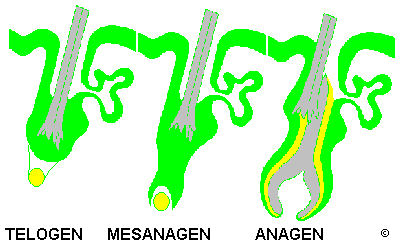
Normally this cycle of hair production and inactivity will continue for the duration of the individual’s life but other factors can influence and inhibit hair production and in some cases lead to physical destruction of the hair follicle. Factors may include adverse reactions to drugs and cosmetics, or as a result of scarring, tumors, radiation, the genetics of the individual, hormones and/or their immune system. And that of course brings us back to alopecia areata where the growing anagen hair follicle is apparently the target of immunological attack.


